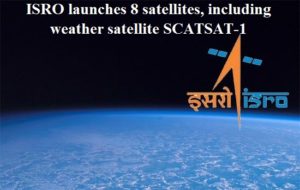The PSLV C35 Polar Satellite Launch Vehicle, carrying three satellites from India, three from Algeria, and one each from Canada and the US, lifted off from Sriharikota in Andhra Pradesh and the launch was “100 per cent successful”.
About PSLV :
The Polar Satellite Launch Vehicle, commonly known by its abbreviation PSLV, is an expendable launch system developed and operated by the Indian Space Research Organisation (ISRO).
- It was developed to allow India to launch itsIndian Remote Sensing(IRS) satellites into Sun-synchronous orbits, a service that was, until the advent of the PSLV, commercially available only from Russia. PSLV can also launch small size satellites into geostationary transfer orbit (GTO).
- In the year 2015 alone India successfully launched 17 foreign satellites belonging to Canada, Indonesia, Singapore, United Kingdom and United States. Some notable payloads launched by PSLV include India’s first lunar probe Chandrayaan-1, India’s firstinter planetary mission, Mangalyaan (Mars orbiter) and India’s first space observatory, Astrosat.
PSLV C35 :
India’s Polar Satellite Launch Vehicle, in its thirty-seventh flight (PSLV-C35), launches the 371 kg SCATSAT-1 for weather related studies and seven co-passenger satellites into polar Sun Synchronous Orbit (SSO). Co-passenger satellites are ALSAT-1B, ALSAT-2B, ALSAT-1N from Algeria, NLS-19 from Canada and Pathfinder-1 from USA as well as two satellites PRATHAM from IIT Bombay and PISAT from PES University, Bengaluru.
 SCATSAT-1 was placed into a 720 km Polar SSO whereas; the two Universities / Academic Institute Satellites and the five foreign satellites will be placed into a 670 km polar orbit. This is the first mission of PSLV in which payloads were launched into two different orbits.
SCATSAT-1 was placed into a 720 km Polar SSO whereas; the two Universities / Academic Institute Satellites and the five foreign satellites will be placed into a 670 km polar orbit. This is the first mission of PSLV in which payloads were launched into two different orbits.- PSLV-C35 was launched from the First Launch Pad (FLP) of Satish Dhawan Space Centre (SDSC) SHAR, Sriharikota.
- After PSLV-C35 lift-off at 0912 hrs IST from the First Launch Pad with the ignition of the first stage, the subsequent important flight events, namely, strap-on ignitions and separations, first stage separation, second stage ignition, payload fairing separation, second stage separation, third stage ignition and separation, fourth stage ignition and cut-off, took place as planned.
- After a flight of 16 minutes 56 seconds, the vehicle achieved a polar Sun Synchronous Orbit of 724 km inclined at an angle of 98.1 degree to the equator (very close to the intended orbit) and 37 seconds later the primary satellite SCATSAT-1 was separated from the PSLV fourth stage.
- After separation, the two solar arrays of SCATSAT-1 satellite were deployed automatically and ISRO’s Telemetry, Tracking and Command Network (ISTRAC) at Bangalore took over the control of the satellite.
- In the coming days, the satellite will be brought to its final operational configuration following which it will begin to provide weather related services using its scatter meter payload. The data sent by SCATSAT-1 satellite will help provide weather forecasting services to user communities through the generation of wind vector products as well as cyclone detection and tracking.
- After the successful separation of SCATSAT-1, the PSLV-C35 mission continued.Still carrying the seven co-passenger satellites, the fourth stage of PSLV coasted over the South Polar Region and then started ascending towards the Northern hemisphere. A safe distance between the orbiting SCATSAT-1 and PSLV-C35 fourth stage was maintained by suitably maneuvering the stage.



 SCATSAT-1 was placed into a 720 km Polar SSO whereas; the two Universities / Academic Institute Satellites and the five foreign satellites will be placed into a 670 km polar orbit. This is the first mission of PSLV in which payloads were launched into two different orbits.
SCATSAT-1 was placed into a 720 km Polar SSO whereas; the two Universities / Academic Institute Satellites and the five foreign satellites will be placed into a 670 km polar orbit. This is the first mission of PSLV in which payloads were launched into two different orbits.

